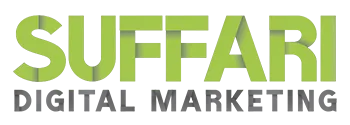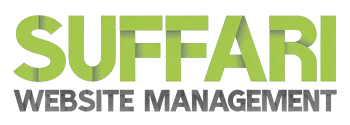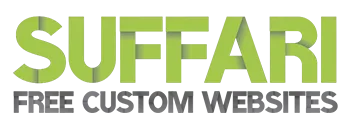
How to choose a Domain Name for your Business - Suffari
Securing an available domain name that fits your business can be quite challenging, particularly when aiming for a .com address that aligns perfectly with your business or brand name. Often, people select their brand name first and only later consider purchasing the domain, mistakenly assuming the matching .com domain is still up for grabs—a rarity in today’s world. This oversight can lead to significant complications later, especially for businesses planning to operate online. Additionally, there are multiple factors to investigate concerning domain names. In my view, choosing your domain should be the very first step. Continue reading to discover more about domains and how to identify the perfect domain name, e.g. "BrandName.com" for your business or brand.
How to choose a Domain Name for your Business | Suffari
How to find the perfect .com Domain Name for Your Business or Brand?
Which comes first, choosing a domain or brand name?
A Step-by-Step Guide to finding a .com domain name that matches your brand name.
Step #1: Understanding Brand Names and Domain Names
Five Essential Traits of an Effective Brand Name
Understanding Domain Extensions
Why are .com Domains Preferred Over Others?
Is it necessary for every company to have a domain name?
Characteristics of the perfect domain name?
Is it necessary for your brand name and domain name to be identical?
When is it acceptable to choose an alternative domain extension?
Step #2: Obtain Suffari’s Domain Idea Kit
Step #4: Utilize GoDaddy’s Advanced Search Tool
Step 5: Discover Expired Domains Using This Powerful Tool
What exactly is an expired domain?
Utilizing the Domain Idea Kit for Expired Domain Searches
How long does domain research take?
Step 6: Compile a List of Available .com Domain Names
Step 7: Select Your Top 10 Domain Names
Step #8: Conduct Domain Due Diligence
Step #9: Select Your Top 3 .com Domains
How to find the perfect .com Domain Name for Your Business or Brand?
As new websites are being built every day at a rapid pace, high-quality “.com” domains are becoming scarce. However, don’t worry—there remain valuable "BusinessName.com" domain opportunities if you know where to search and utilize specific tools designed for uncovering these hidden gems. Understand why it’s crucial to have your brand and domain name in harmony. If your desired .com domain is already taken and you have an established brand name, there’s no need to panic! We'll show you how to find one. In this guide, I’ll lead you through each stage of my creative process combined with thorough research. Additionally, you’ll receive Suffari’s Domain Idea Kit, packed with domain name suggestions, links to essential online tools, and a Domain Due Diligence Checklist to help you avoid typical pitfalls when choosing a domain.
Which comes first, choosing a domain or brand name?
Ah the old “chicken or the egg” debate. Which should I do first, the brand name or the domain name? Surprisingly enough, most people start with the brand name, only to find out later that someone else already owns the domain name. This can lead to huge problems down the road, especially if someone else owns the matching .com domain name already and is selling similar products. You can essentially become their free marketing partner and simply give them your business, customers, and web traffic. That’s why my branding process always starts with searching available .com domain names.

A Step-by-Step Guide to finding a .com domain name that matches your brand name.
For the purposes of this guide, domain names, business names, and brand names are essentially the same thing. Our goal is to find an available dot com domain name for your new business or brand that matches. We do this buy choosing the domain name first to ensure your .com domain name is available and then your brand name will match. Here's the steps I do to find a list of 1-2 word available .com domain names with specific criteria to match your business.

Step #1: Understanding Brand Names and Domain Names
What Defines a Brand Name?
A brand name serves as the primary identifier of your business in the eyes of potential customers. It should be distinctive, relevant, easy to recall, and capable of creating an emotional bond between your audience and the company.
Five Essential Traits of an Effective Brand Name
Memorable: To ensure your brand stays in people's minds after just one or two encounters, craft a name that is catchy or witty, helping it stand apart from competitors.
Distinctive: Your brand must possess a unique identity. Reflect on the feelings you want your audience to associate with your company’s name and generate ideas that embody those emotions to differentiate yourself in the market.
Emotionally Engaging: The first impression your business name creates should spark interest or emotion, immediately capturing attention so people feel compelled to learn more about your offerings.
Concise: Keep the brand name brief—ideally one to two words—avoiding articles like “the” or “a.” Refrain from using hyphens and limit the syllable count generally to between two and three, with a maximum of five syllables.
Easy to Pronounce: Select names that are simple to say, ensuring customers can easily share your business with others. Aim for words familiar enough to pronounce effortlessly, yet unique enough to remain memorable.
What defines a Domain Name?
A domain name functions as the web address used to locate a website online. For instance, suffari.com represents our domain name. It acts as the digital identifier for companies, organizations, or individuals. An effective domain name should be memorable, easy to say, and relatively short—preferably no longer than around 15 characters. Avoiding hyphens and numbers is advised unless the numbers are an integral part of the brand.
Understanding Domain Extensions
A domain extension, also known as a top-level domain (TLD), is the ending segment of a website’s URL that signifies the category of the site. Popular domain extensions include .com for commercial entities, .net for networks or organizations, and .org for nonprofit groups. In addition, several extensions are country-specific, such as .us for sites within the United States and .ca for those based in Canada.

Why are .com Domains Preferred Over Others?
Many people choose .com domain extensions because they are strongly associated with business and commercial sites. Since their introduction in 1985, .com domains have become so prevalent that users often assume every website ends with “.com.” This widespread recognition helps foster trust among potential customers and enhances the credibility of a business by presenting a more professional image.
Is it necessary for every company to have a domain name?
Absolutely. Ideally, your company’s domain should correspond to your brand name, use a .com extension, and host a website at that address. Nonetheless, even if your domain doesn’t precisely align with your brand or you don’t maintain a website yet, owning a dedicated business domain still offers advantages. These include having uniform company email addresses under the same domain and the option to create a website later on.
Characteristics of the perfect domain name?
An outstanding domain name typically has the following characteristics:
Concise: Ideally consisting of one to two words at most.
Correct Spelling: Comprised of correctly spelled English words (such as Amazon) or a brief, distinctive brand name of 2 to 6 letters (for example, Hulu).
Domain Extension: Uses the “.com” extension, which is the most popular domain ending in the United States.
Availability: The chosen domain name must be accessible and not already taken.
Brand Consistency: It should correspond with your brand’s name.
Is it necessary for your brand name and domain name to be identical?
Yes. They should match. However, not all brand-matching .com domain names are available.
When is it acceptable to choose an alternative domain extension?
There are several situations where opting for a different domain extension makes sense.
One scenario is when the “.com” domain you want is available but currently out of your budget, though you anticipate being able to afford it in the near future. For instance, if Suffari.co costs $15 but Suffari.com is priced at $3,000, you might decide to start with Suffari.co and hope the .com becomes accessible later.
Another case is when the price of the “.com” domain is prohibitively expensive, making it unlikely that anyone would pay such a high cost to imitate your brand. For example, if Suffari.co costs only $15 whereas Suffari.com is $100,000, you can reasonably assume no competitor would spend that much to copy you. By the time this could become a threat, your business will likely be well established, and you may even have the means to purchase the .com yourself.
If your company operates locally without engaging in eCommerce and your website’s purpose is solely to strengthen brand awareness within your immediate area, then using a non-.com extension works. In this case, your Google Business profile on Google Maps will help you appear on the first results page for nearby searches.
Using a different domain extension may also be appropriate if your organization is not commercial in nature. Various domain extensions cater to specific types of entities—for example, non-profits often opt for a “.org” domain.
Sometimes the “.com” you desire is already owned by someone in a completely unrelated industry. Although this situation isn’t ideal, the main priority is to prevent losing customers to other businesses. If "YourBrand .com" belongs to a company that sells auto parts, for instance, choosing an alternative like “.co” or “.us” is acceptable. However, this option should be a last resort because it involves competing with the current owner in Google search rankings. Since you’ll be fighting for visibility under your brand name keyword, it’s essential to evaluate the .com owner’s search performance by searching your brand name and analyzing their positioning and authority on page one. If it appears unlikely you can outrank them, you might need to consider selecting an entirely different brand name. Explore every other domain option before resorting to this approach.
Keep in mind, the main objective here is to select a domain name that aligns with both your website and brand identity. In most cases, the exceptions outlined above won’t apply, or better alternatives will be available.
Step #2: Obtain Suffari’s Domain Idea Kit
Having established a solid understanding of what domains entail, it’s time to dive into the enjoyable task of discovering the ideal domain for your new brand or project. To begin, you'll require a few essentials:
First, download and open the Domain Idea Kit. Inside the Excel file, you’ll notice multiple tabs at the bottom of each worksheet; these will be referenced throughout the upcoming sections.
Next, launch a web browser, as you will need to access certain links found both within the Domain Idea Kit and later in this guide.
If followed thoroughly, this process will demand several hours per day over the span of at least three days. While it’s possible to speed through it, I highly suggest investing adequate time to ensure it is done properly.

Click the link below to download the Domain Idea Kit, which is an Excel spreadsheet containing word suggestions, step-by-step instructions for searching domains on GoDaddy and ExpiredDomains.net, curated lists of top domain ideas, and a checklist for due diligence. Portions of this resource, including the word brainstorming section, are also available for review below.
Step 3: Generating Word Ideas
The foundation of developing a brand name alongside a fitting domain name lies in the fundamental element: words. While we emphasize words within a domain name, essentially, this refers to your brand’s name. What designation will you choose for your business, brand, or identity—what term or terms will your audience associate with you?
To help expand your list of possible brand names, I recommend temporarily setting aside all existing ideas to open up your creative possibilities. Then, access the Domain Idea Kit and select the “WORDS” tab. Within this worksheet, you will encounter several columns featuring industry-specific vocabulary, frequently used brand name terms, fragments such as word prefixes and suffixes, as well as intentional misspellings. For those who have not yet downloaded the Domain Idea Kit, a breakdown of these columns is provided below, categorizing various types of words you might consider for your emerging brand name.
WORD BRAINSTORMING
Within the “WORDS” section of the Domain Idea Kit, you will find these categorized lists. To help you get started, I’ve included some frequently used terms. Choose words that align with your vision and the brand you plan to build. Feel free to add your own words to each category. In the following section, these word collections will serve as the foundation for exploring available .com domain names.
WHAT DO YOU OFFER?
Consider the product, service, or the outcome your product or service delivers. Write one word per line.
Web Design
Website Management
SEO
Digital Marketing
Email Marketing
SMS
Content
Design
Funnels
Lead Generation
TERMS FROM YOUR INDUSTRY
Here are several common terms from the industry that might be useful in creating a branded domain name.
Traffic
Rank
Click
Lead
Engagement
Sales
Funnel
Content
Campaign
Digital
Marketing
Online
ADJECTIVES AND DESCRIPTORS
Most brand names made up of two words often pair an adjective or descriptor with a noun (such as a person, place, or thing). Below is a list of popular descriptive words.
Enhanced
Easy
Simple
Simply
Totally
Free
Insane
Zen
Lively
Wild
Sweet
VERBS, ADVERBS, & ACTION WORDS
Certain brands incorporate particular action-oriented terms to depict their business activities. Below is a selection of verbs, adverbs, and related dynamic words used for this purpose:
Live
Assist
Care
Rank
Rocket
Go
Grow
Boost
WORDS CONVEYING SUPERIORITY
Words that imply excellence or dominance in the market signify statements like “We lead the industry” or “Better than competitors.” These terms can be integrated either at the start or the end of a two-word brand name. Examples include:
Super
Imperial
Top
Plus
Pro
Big
Master
Best
Better
Alpha
Supreme
TERMS RELATED TO SHOPPING
Ecommerce brands frequently utilize shopping-related vocabulary to define their business. Although it is common for companies to incorporate such terms into generic domain names for SEO advantages linked to transactional keywords, search engines have become more sophisticated. If used creatively, these words can be part of a brand or domain name, but avoid overly obvious keyword pairings such as “Buy Products .com,” which would not make a strong brand. In contrast, names like “Kiosk” are more effective. Examples include:
Shop
Shopping
Cart
Kiosk
Store
Stock
Depot
Discount
Deal
PEOPLE & GROUPS OF PEOPLE
Brand names that reference specific individuals, types, or groups can be memorable and also clarify the intended customer base. For instance, “Soldier Web Design” clearly targets American veterans. Alternatively, unique and distinctive names such as “Website Jedi” or “Ninja” can make a brand stand out. Examples are:
Buddha
Cowboy
Cowgirl
Master
Ninja
Jedi
Tyson
Grower
Farmer
Convict
Army
Convoy
Soldier
Pilot
Critic
OBJECTS
Here is a list of various nouns that may inspire creative brand naming and help identify an available domain:
House
Globe
Science
Planet
Diamond
Platinum
Gold
Silver
Pros
Agency
Leaves
Therapy
Wagon
Choice
Freedom
BEGINNINGS OF WORDS
Below is a collection of frequently used initial words, partial words, and alphanumeric prefixes that often appear at the start of brand names, typically combined with another term.
Site
Web
TKO
A1
AAA
Pyro
Doc
Dr
NextGen
COMMON ENDINGS
Here is a selection of typical suffixes or word fragments frequently found at the conclusion of brand names and domain titles. Pair these endings with your chosen words to explore possible catchy brands that might be available as a .com domain.
Bay
Lively
Planet
Slim
Bounty
Assure
Well
Leaf
Relief
Café
Cart
Ly
Total
Army
XL
Sphere
ipedia
Illy
Alley
itime
opia
omight
oid
ology
ALTERNATIVE SPELLINGS AND SLANG VARIATIONS
Modifying an “S” to a “Z” or adding “S” or “PE” is a popular trend. Yet, be mindful that Google might downrank your site if it detects the misspelling and promotes more conventional spellings instead. Furthermore, misspellings tend to appeal predominantly to a younger audience, so if targeting professionals such as Chiropractors, using correct spelling in your brand is advisable.
Boyz
EZ
Kart
Cowboyz
Cowgirlz
Labz
Pluss
Shoppe
WORDPLAY NAMES
These are creative but straightforward fusions of words blended into a single term. Take care that the meaning of the original words is not lost in the combination.
Releaf (relief + leaf)
BizEZ (business + easy)
ShopNgo (shop + and + go)
COLOR-BASED NAMES
Using color names is an excellent strategy for branding. Whether it’s White Tiger, Purple Elephant, Red Robin, or Aqua Vapes, color words often create memorable and striking brand identities.
Red
Orange
Yellow
Green
Blue
Purple
Brown
Black
Aqua
Ivory
Gray
Pink
LOCATIONS
Incorporating locations can effectively evoke immediate recognition and a sense of connection with a place. Yet, it’s important not to confine yourself too narrowly to a particular city or region when doing so. For instance, if your brand is named Miami Marketing, individuals browsing online from Wisconsin are unlikely to visit your site.
Farm
Galaxy
Planet
Space
Southside
Spot
Earth
Vegas
Red Rock
Mississippi
East Coast
West Coast
Compton
Florida
Orlando
Miami
Malibu
World
ANIMALS
Animals rank among my favorite themes to incorporate. They blend well with nearly anything, making them ideal for creating compelling brand and domain names. Consider examples like MailChimp or Firefox.
Bear
Monkey
Cheetah
Lion
Squirrel
Cricket
Frog
Ant
Grizzly
Gorilla
Hog
Leopard
Panther
Dog
Cat
Tiger
Unicorn
Zebra
Owl
Koi
Eel
Jay
Hogg
Mink
Lynx
Paco
Wolf
Puma
Mouse
Whale
Sloth
Viper
Raven
Eagle
Badger
Beaver
Bobcat
Cougar
Dexter
Donkey
Impala
Jaguar
Raccoon
Chipmunk
Elephant
Mule
Lamb
Chimp
Crow
Doggy
Fox
Croc
EDGY TERMS FOR A REBELLIOUS TONE
Words with an edgy vibe resonate well with younger demographics, adding a level of shock value that makes them unforgettable. Nevertheless, these tend to appeal mainly to a younger adult group.
Junky
Mob
Convicts
Hustle
Dope
Outlaw
Kickass
Badass
NOTABLE NAMES
You might want to associate your new venture with some of history’s most famous or notorious figures, which can also help you attract a particular segment of your audience.
Gatsby
Lincoln
Washington
Trump
Manson
Vader
Don
Pablo
Capone
Gotti
Dillinger
Griselda
Blanco
Gambino
Luciano
Lars
Axel
Snoop
Dre
Arthur
UNIQUE WORDS "ONLY YOU KNOW WHAT THEY MEAN"
These can range from invented terms from your youth to amusing nicknames. Any word can become part of your brand. Such choices are advantageous since domains containing these kinds of words are often still up for grabs.
__________
__________
Combine these words with one another or use them as inspiration to explore different vocabulary options for your brand name. Keep an open perspective and try pairing elements you wouldn’t normally link. For instance, select a color and an animal to create a brand name like “Pink Monkey” or “Purple Elephant.” Remember, your brand name doesn’t have to include words with the products or services you sell.” We included that, but many of the world’s most successful brands’ names don’t reflect the products they sell. That’s the essence of branding—through marketing and repeated exposure, a word or phrase becomes synonymous with your offerings.
If you’re working with the Domain Idea Kit, start inputting your own terms into each category and complete the final column labeled “ONLY YOU KNOW WHAT THEY MEAN WORDS.” If not, compile your own list using the suggested word types below that resonate with you. Soon, we will use your selected words to search for available “.com” domains using two excellent tools: GoDaddy and ExpiredDomains.net. Below, you’ll find examples and categories of potential brand and domain name words.

Step #4: Utilize GoDaddy’s Advanced Search Tool
GoDaddy stands as the leading domain registrar in the U.S., and we recommend purchasing your domain through them. However, avoid obtaining your hosting or using their website builder services. Before you begin searching for your new Brand Name .com domain on GoDaddy, it’s crucial not to rely on their standard search tool. Since GoDaddy offers domains from numerous extensions, their default search tends to promote domains beyond just .com. To focus solely on .com options and filter out hyphenated names, costly Premium Domains, and overly long domains, make use of GoDaddy’s Advanced Search Tool instead. Follow these steps:
1. Access GoDaddy’s Advanced Search Tool via this link.

2. Select the ".com" filter to limit your results exclusively to .com domains.
3. Configure the search filters accordingly.
4. Enter two words into the Search Query Box.
5. Hit "Search Domains."

6. Review the results along with all the suggested alternatives.
(Note: Avoid using GoDaddy’s domain broker service.)

7. Copy any promising domain names into the “TOP 100” tab of your Domain Idea Kit or another list-making tool.
8. Repeat steps 4 through 7 using different word combinations generated during your brainstorming.
9. Continue this process until you have gathered approximately 50 potential domain names.
Step 5: Discover Expired Domains Using This Powerful Tool
What exactly is an expired domain?
An expired domain refers to a web address previously owned by someone else. Its value to you might vary, especially if it has been utilized before, offering SEO benefits through backlinks and anchor texts from the same industry. At minimum, the domain’s age can provide some advantages.
Expired Domains .net

ExpiredDomains.net stands out as one of the most comprehensive and free domain search platforms available, boasting thousands of customizable filters.
I selected this tool because it offers precise filtering capabilities, enabling you to locate an exceptional 1- or 2-word brandable .com domain. While there are countless filters to choose from, here are some of my favorites:
- Keywords
- Keyword Positioning (whether it starts or ends with the keyword)
- Word Count
- Language
- Availability
- Price
- Domain Extension
- Character Length
- Hyphen Exclusion
- Number Exclusion
- Backlink Data
- Internet Archive Records
Now, let’s begin the process of using ExpiredDomains .net to find a concise, 1-2 English word .com brand domain. Once you identify a domain that appeals to you, copy it and paste it into the “TOP 100” tab of your Domain Idea Kit or compile it in your preferred list management tool.
Step 1: Navigate to ExpiredDomains .net and register for a free account by clicking on “Sign Up,” then create your username and password.

Step 2: If you’re not already logged in after registration, log in to your account.

Step 3: Select the “Deleted .com” tab to filter exclusively for .com domains.

Step 4: Click “Show Filter” to reveal the search criteria.

Step 5: Adjust the following filters to refine your domain search:

Domain Name Settings:
- Tick the “No Hyphens” box
- Set the maximum number of characters to “25”
Dictionary Word Domains:
- Check “English”
- Set minimum word count to “1”
- Set maximum word count to “2”
Listing Settings:
- Select “Only Available Domains”
- Set the maximum price to “100”
With these settings, you’ll be well-equipped to find high-quality expired .com domains suitable for building a strong brand.
Step 6: In the same area where you’ve just chosen your filters, look at the top left corner—there you’ll find three input fields labeled:

- Starts with
- Contains (anywhere)
- Ends with
This is where you enter the keywords for your search.
IMPORTANT: Use spaces to separate multiple keywords; do not use commas.
At this stage, select up to 30 words from your brainstorm list and enter them, separated by spaces, into the “Contains” field. Alternatively, if you want to specify words that should appear at the beginning or the end, use the “Starts with” and “Ends with” fields accordingly. You may also utilize the Domain Idea Kit’s “Starts Ends With” tab, which provides pre-arranged sets of around 30 words for both the starting and ending positions. See details below.

Utilizing the Domain Idea Kit for Expired Domain Searches
Another helpful tool is the Domain Idea Kit. Its fourth tab, titled “Starts Ends With EXPDOMAINS .NET,” contains several columns:
- COMPLETE – Mark this box once you’ve finished reviewing the “Starts with” and “Ends with” keywords for that row.
- STARTS WITH – Copy these words into the “Starts with” filter on ExpiredDomains .net.
- ENDS WITH – Paste these words into the “Ends with” filter on ExpiredDomains .net.
- DOMAIN 1, 2, 3 – Record any domain names you find appealing here.
Each box includes roughly 30 words, and if you work through every row, you’ll cover a vast array of keyword combinations from your brainstorming session. Though this process can be time-intensive, it’s highly effective for uncovering great domain names.
When you identify a domain you like, log it under one of the DOMAIN columns. Once completed, transfer your top selections into the TOP 100 tab, compiling your favorite potential domain names to refine further the following day.
How long does domain research take?
The duration varies. If luck is on your side, you might finish in under an hour. However, conducting a comprehensive search—exploring all possible options and carefully narrowing them to ensure you choose the perfect brand-aligned .com domain—will require several hours. Ideally, spread this work over about three days, dedicating a few hours each day, to perform thorough due diligence and make a confident decision.
Step 6: Compile a List of Available .com Domain Names
Begin by merging your brainstorming results with tools such as GoDaddy’s Advanced Search and ExpiredDomains.net to gather a minimum of 50, ideally close to 100, domain name options. Although this number may appear excessive, once centralized, you will notice that only around 10% truly stand out as viable candidates. Highlight or mark the domains that catch your interest on your list.
It is crucial—no, essential—not to rush through all these steps in a single day. While you may complete steps 1 through 7 in one session if desired, after finishing step 7, take a break for the day and revisit the list with a refreshed and clear mindset the following morning.
Step 7: Select Your Top 10 Domain Names
Upon reviewing your list of around 100 domains with fresh eyes and reconsidering your favorites, narrow down your selection to the top 10 potential domain names. These will be the focus of further investigation in the subsequent step. If you find it challenging to trim your options, consider these ten criteria to help refine your choices:
1. Double Consonants – Avoid domains where the first word ends and the second word begins with the same letter, as this can lead to visual confusion and mispronunciations.
2. Creation of New Words – If combining two words creates an unclear or awkward new word that hampers readability, it might be best to discard that domain.
3. Odd Sounding Names – Pronounce the domain out loud. If it sounds strange or off, reevaluate its suitability.
4. Length – Favor brevity; shorter domain names are generally more effective.
5. Misspellings – Unless the misspelling is a single word under eight letters, exclude domains with intentional or unintentional misspellings if better options exist.
6. Acronyms – Exclude domains that rely on acronyms to avoid frequent explanations to customers.
7. Articles – Remove domains containing words like “the,” “and,” or “a.”
8. Sales-Related Terms – Exclude domains featuring words like “Buy” or “For Sale.”
9. Potential Confusion – Avoid domains that could be mistaken for well-known existing brands to prevent future complications.
10. Extensions – Prioritize .com domains over other domain extensions.
Step #8: Conduct Domain Due Diligence
If you take away only one thing, let it be this. After narrowing down your list of potential branded domains, it’s crucial to perform thorough due diligence. This step ensures you won’t fall into a pitfall caused by selecting a domain or brand name previously associated with negative connotations or damaged reputations. Picture discovering the perfect domain that matches your brand, then investing in labels, products, and building a full website—only to later find numerous unfavorable customer reviews linked to that name online, with accusations of scams related to “Your Brand.” Additionally, be mindful of possible legal complications involving wordmarks, prior SEO backlink history, or problematic translations.
Refer back to sections #3 and #5 of this guide, noting that “Brand” and “Domain” can be used interchangeably here since the aim is to align both your brand and domain seamlessly.
For your Top 10 domain choices, verify these critical points:
- Unfavorable anchor text associations
- Former ownership by questionable companies
- Negative reputation history
- Google search results dominated by competing brands
- Potential wordmark infringements
- Misleading or harmful translations
For a deeper understanding of these aspects, check the linked article provided.
Step #9: Select Your Top 3 .com Domains
This stage is straightforward: choose your three favorite .com domains that best represent your brand. At this stage, feeling a bit anxious about losing one or more options is normal—if so, consider buying one or all three domains for under $50 to secure peace of mind. Owning multiple domains isn’t wasted effort; you might use any extras to host a blog or create backlinks supporting your primary website.
Then, take a final moment to “sleep on it.” Unless you are absolutely certain about a domain name, give yourself another night to reconsider. I’ve often found that after processing large amounts of information rapidly, perspectives shift with a rested mind and fresh viewpoint.
Step #10: Purchase Your Domain
We suggest acquiring your chosen domain through GoDaddy. Once the purchase is complete, congratulations! You’ve successfully secured your domain and brand name—a combination that many would call a fantastic two-for-one win. Hopefully, you’re very pleased with this milestone for your brand’s online identity.
What should you do next?
Step 1: Direct your domain to your server or hosting provider, such as Siteground.
Step 2: Begin creating your website or get in touch with Suffari to receive a free customized website.
Step 3: Enroll in Suffari’s website management plan, which offers SEO and marketing services bundled into one affordable monthly fee with no initial setup charges.
Conclusion
In summary, selecting a .com domain name is crucial. Securing one that matches your brand name puts you in an excellent position to succeed. However, if the .com domain is already owned by someone else, you risk losing web traffic from customers who mistakenly visit their site instead of yours. Even if you’re not currently selling products online, having the option to do so later—or at least establishing a branded website—is essential. Therefore, starting with the domain name is an ideal first step when launching a company.
Thank you for taking the time to read this guide; I hope you found it useful. This is the exact approach I use when developing new brands. Should you have any questions or require eCommerce web design or graphic design services, please feel free to contact me by phone at any time. Thank you for choosing Suffari. Wishing you success!























Youtube